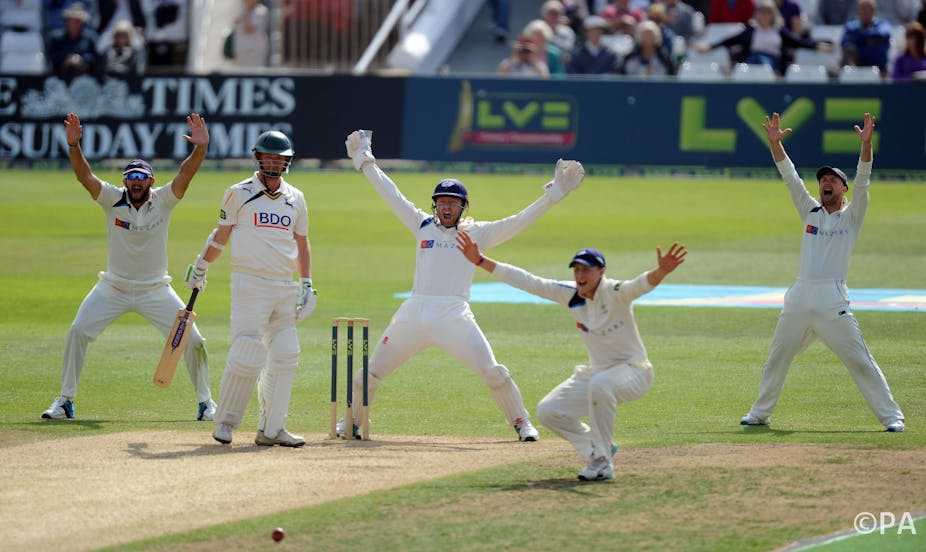Cricket attendance in the UK is on a steady decline, falling from about 1.8m going to games in 2004 to less than 1.4m in 2011. But the success of websites about the sport and the continued interest among satellite viewers suggest it is keenly followed by fans outside of the stadium. In fact, the growth of this kind of indirect consumption of the sport shows it has growth potential, but this is yet to be capitalised on.
As a professional sport, cricket is somewhat unusual in that it is played in three versions over the course of a six month season. First class is played over four days, one day matches last about seven hours and Twenty20 is played over three to four hours. These evolutions of the game have been made to make it more palatable to wider audiences. But it does make match scheduling harder than in most other sports, from both a team and spectator perspective.
My colleague Adrian Pritchard and I decided to investigate the decline in spectators going to watch games and examine the way the sport is consumed and engaged with. To do so we surveyed 632 crickets fans over the course of the 2011 cricket season. Working in collaboration with the Cricket Supporters’ Association, our focus was on the domestic league, which does not tend to receive the same level of interest as international matches.
In our research published in Leisure Studies, we included indirect consumption, following both the sport and a given team outside the stadium. This type of consumption has increased in recent years as satellite providers have started broadcasting matches. In addition, the development of online platforms allows fans to have a multitude of options as to how they follow the sport.
Engagement outside of matches
The use of the internet is very evident in our research. More than 95% of respondents followed their county team on the internet, 85% attended games during the season and over 65% watched highlights of their games. Having said that, this format is seen as inferior to live cricket, 94% saying that they would rather attend a match than watch it on TV or online.
This clearly indicates that there is a hierarchy of how the sport is enjoyed. Although it is the preferred mode, the time involved acts as a barrier to going to games, and 75% of our respondents said that other commitments interfered with their attending matches. Interestingly the price of admission to domestic matches was not seen as a barrier as nearly 90% of respondents thought tickets were good value for money, whereas only 29% thought this for international matches.
This supports the view that there are cricket fans that follow the sport but do not attend matches. The advent of technology has led to a pattern of mixed consumption with indirect consumption exceeding attendance in terms of supporter numbers and also probably time spent.
A problem for marketers
This rise of indirectly engaging with cricket has not yet been capitalised on. Indeed, it is proving a problem for marketing managers because of the difficulty they have with keeping track of both the market size and behaviour.
Much of the indirect engagement that takes place, such as following your team on the internet, is peripheral to the actual game and often takes place when games are not in progress. For example when people go online and read about the latest team news between games or visit websites for pre and post-match analysis. These activities complement the sport and are likely to increase spectator interest.
A detailed knowledge of these alternative ways of engaging with the sport would help when marketing it to the sponsors and broadcasters who provide most of its income. At present, however, their interest lies mainly in the national team, as they are judging interest in the sport by those who watch matches live and so are underestimating the interest in the domestic game.
Social opportunities
Despite these problems, there are now more opportunities to become involved in domestic cricket, which may in turn bring more opportunities to socialise, both online and face to face. This is an important factor in getting people involved in a sport, particularly in domestic cricket.
Our results support this, indicating the importance of socialising and also noting its positive impact on preference for a sport. More than 80% of people in our study said they enjoyed attending matches with friends, and liked to talk to people sitting near them at matches. In addition more than 70% said matches provided them with great opportunities to socialise.
So, despite the decline that has been taking place in attendance at live games, cricket should not be written off as a popular sport in the UK or elsewhere. The rise in online platforms to engage with the sport and the potential there is for socialising means it has great potential to engage increasing numbers of people. Broadcasters and sponsors would do well to take note.

